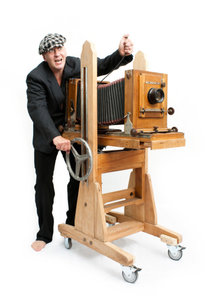In this day and age...

Two photographers spoke to me and a group of mothers this week in an attempt to sell their photography packages. It all sounded very good to start with. They would come to your house and capture the natural little moments you share with your little infant, taking more than 30 photos for you to pick from. Depending on the package you are on, you then get to select the pictures that you would like printed for you, starting at £90 if you chose to only have one print. Frames would cost extra, and photobooks start at £240.
Curious, I asked, “How much would you charge if I just wanted the digital copies?”
“We don’t do that,” was the reply.
She went on to explain, “We want the photos to be printed in the best quality print, so we’d prefer it if we print them for you.”
 I found that bizarre as so many of us now store our photos digitally and might decide what to do with our photos and how we want them printed at a later date. Judging from the price their services would cost, I was genuinely surprised that we were not offered the finished product in its full high res digital version to keep.
I found that bizarre as so many of us now store our photos digitally and might decide what to do with our photos and how we want them printed at a later date. Judging from the price their services would cost, I was genuinely surprised that we were not offered the finished product in its full high res digital version to keep.
But upon surveying the photography market, it became clear that this was not an uncommon occurrence, especially among the established studios. However, speaking to the other mothers, it struck me that such photography packages held no interest for most of them. Those that wanted good quality photos taken of their babies would either engage a freelancer who is willing to offer a deal including the digital copies, or take the photos themselves. And with modern photographic equipment like SLR cameras and photo editing programmes like Photoshop becoming commonplace in many households these days, the latter is not hard to do.
 In a time where we can make our own poster-sized prints, create our own photobooks, and even have our favourite photo on our pillow cover if we so choose, photographers just cannot afford to be stubborn and hold on to their old business models, whether it be for pride or profit. Those that do would lose out eventually.
In a time where we can make our own poster-sized prints, create our own photobooks, and even have our favourite photo on our pillow cover if we so choose, photographers just cannot afford to be stubborn and hold on to their old business models, whether it be for pride or profit. Those that do would lose out eventually.
And this got me thinking about the English teaching industry.
Are we also fixed in our ways of teaching that we think we know best and are not paying close attention to how our students’ needs have changed over the years?
Are we insisting that our students put their mobile phones away in the classroom when these devices could in fact be great tools for learning?
Are we still repeating the same old tired texts for reading practice when the internet offers up more current and relevant articles to be exploited?
Are we offering listening practice solely with audio files (eg cassettes or CDs) even when so much of the audio we encounter is accompanied by video these days?
Are we still using precious classroom time getting students to learn to write letters?
And when we have them writing emails, do we still insist on the formality and styles of letter-writing?
Do we still think of essay-writing as the main way of improving writing skills, alongside the ever-so-useful book and film review?
Or do we get students to blog in English instead?

Would we consider the discourse patterns of Tweets, Facebook comments and status updates, Instant Messaging and online chats as areas in need of practice?
On the topic of the discourse pattern of Instant Messaging, I’m reminded of my father. My father has recently discovered that What’sApp is a great way of keeping in touch with me. We live in different countries and it allows us to chat, share photos and videos, and exchange thoughts and opinions.
However, my father is a ‘monologue-er’. He is used to speaking at length, uninterrupted, and isn’t even too keen on too many discourse markers peppered in the conversation on the part of the listener. He would prefer it if one waits for him to finish his speech before embarking on their reply. Because of this, emailing has worked very well for him in the past 10 years.
But this discourse pattern somehow does not quite work on an Instant Messaging service like What’sApp. Turns are often shorter (as it is harder to type long paragraphs with one finger on your smartphone), responses are instant, and there are sometimes two threads following two different topics of conversation occurring at the same time.
 After a week of chatting to me, he pleaded with me to slow down. He said that I should wait for him to finish typing his paragraph before replying. Sometimes, a reply would come while he was still typing his next message, and he found it difficult to read the incoming messages while keeping track of what he wanted to say and not losing his train of thought.
After a week of chatting to me, he pleaded with me to slow down. He said that I should wait for him to finish typing his paragraph before replying. Sometimes, a reply would come while he was still typing his next message, and he found it difficult to read the incoming messages while keeping track of what he wanted to say and not losing his train of thought.
Getting used to and coping with the discourse patterns of these new media of communication can often be difficult, and a mistake or faux pas committed could be a lot more public than before.
The discourse involved in ‘real life’ spoken language is by no means any easier. Managing the complexity of turn-taking, learning to hold the floor, trying to hear different people talking all at once can all be very intimidating in a foreign language, even without the added complication of cross-cultural issues.
 Do we rest on our laurels that is the orderly discourse patterns of a classroom where students put their hands up when they want to speak, and open their mouths only when nominated?
Do we rest on our laurels that is the orderly discourse patterns of a classroom where students put their hands up when they want to speak, and open their mouths only when nominated?
Are we still obsessing about the grammatical accuracies of the present perfect versus the past simple when it is clearly the students’ lexical deficiencies and discourse inappropriacies that are causing miscommunication and misunderstandings to happen?
Or are we preparing our students to use their English out there in the world today?
Are we really catering to our students’ needs for English in this day and age?
Or are we like those photographers, holding on to the way things have always been done because that’s the way they’ve always been done?

Chia Suan Chong is a General English and Business English teacher and teacher trainer, with a degree in Communication Studies (Broadcast and Electronic Media) and an MA in Applied Linguistics and English Language Teaching from King’s College London.
A self-confessed conference addict, she spends a lot of her time tweeting (@chiasuan/@ETprofessional), Skyping, and writing. You can find out more about her on her blogsite: http://chiasuanchong.com


Comments
Write a Comment
Comment Submitted